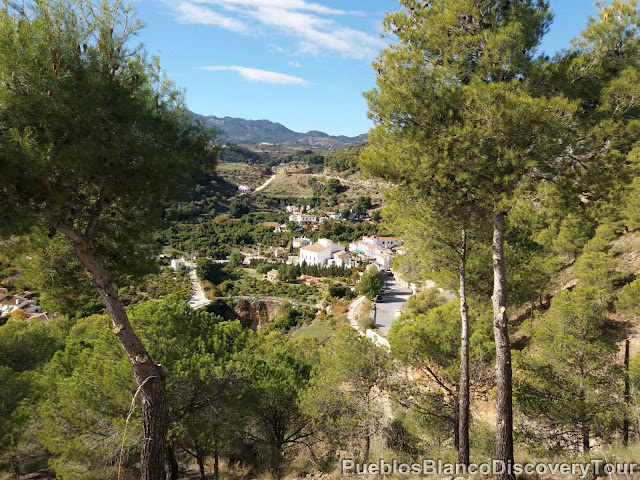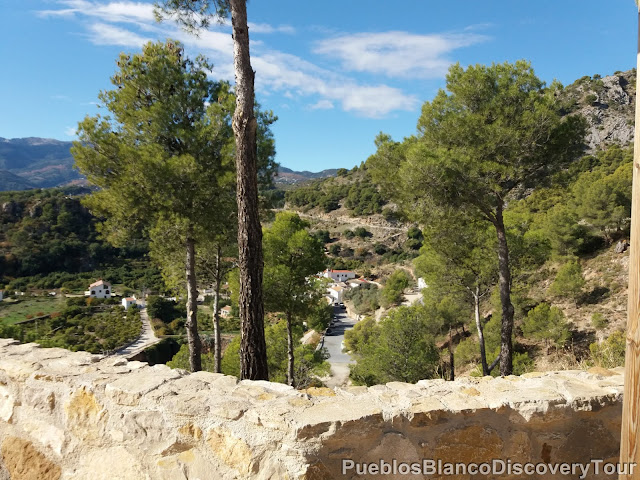A white village
in the Sierra de las Nieves
Prologue:
As soon you as leave the Coast by Marbella, and you drive inland towards the the villages of Ojen and Coin, you enter the Sierra de las Nieves Natural Biosphere.
The village of El Burgo at 591 meters above sea level, is one of the 9 municipalities which share the Nature Reserve. It is located 55 km from Marbella and 27 km from Ronda on the most northern part of the Sierras de las Nieves.
The drive is very scenic and you will have beautiful panoramic views on the way. The landscape is diverse, from rugged forested mountainsides to very lush farmland of olive, orange and almond groves and wheat fields. You will see many small farms scattered on hillsides. The most striking features of the Sierra de las Nieves are the brilliant white and fairly bare looking limestone mountains. The highest peak is the mount Torrecilla (1919m).

Directions:
- From Marbella A-7 you take the road towards Ojén A-355.
- Drive onto Monda, and there you turn towards Guaro/Ronda A-366.
- You bypass the villages of Guaro, Alozaina, Jorox and Yunquera.
- You reach the village of El Burgo after 55 km and approx. 1 h 20 min. drive.
4 km afer the village of Alozaina we stopped at a viewpoint
Mirador de Jorox.
Jorox is a small quiet hamlet set in a deep valley alongside the river Jorox.
Looking straight ahead, on the horizon we can make out the village of Yunquera.
From this viewpoint you are able to see the mountain range of the Sierra de las Nieves with its highest peak Torrecilla (1919m)
The road gently winds through the Nature Reserve of Sierra de las Nieves.
Towards the right, the mountain Sierra Cabrilla (1497m)
Ahead of us the village of El Burgo

El Burgo due to its geographical position has a long and important history, and the river Turón has certainly played a significant roll in it. The first settlers are thought to have been the Carthaginians who built the Hannibal tower to help defend and control the pass between the Ronda plateau and Malága. The Romans also realised the importance of this highway, and the Emperor Trajan granted the road Imperial Privileges, as it was an essential route and staging point for the Roman Legions from Ronda (Arunda and Acinipo) to Ardales, Málaga (Malaca) and beyound.
During the Islamic period El Burgo (Al Burgis) was an important border stronghold and the Moors then built a fortress around the tower.
In 1485 Ronda was conquered by the Catholic Monarchs to whom the inhabitants of El Burgo offered their vassalage. The village thereafter expanded outside the castle walls.
Today El Burgo has a population of about 2000 inhabitants.
We entered the village via a bridge over the Turón river and parked the car near the roundabout with a statue of a mountain goat (La Cabra del Burgo).
The Spanish Ibex is a symbol of the Sierra de las Nieves.
The statue of "Pasos Largos" (long strides).
Juan Mingolla Gallardo is known as the last Bandolero (Bandit) of Andalucía and his birthplace was El Burgo in 1873. He roamed the Serranía de Ronda until his death in March 1934. Each October for 3 days, the village turns its clocks back to the XIX and recreates the historical events of the Passion Bandoleros.
In a little park you find various information boards which describe different routes around the village. The route of the Roman bridge, the Mill route and the Castle route.
From the roundabout we walked back towards the Ronda road A-366 and along Calle Profesor Augustin Garcia which lead us towards the bridge over which we came. From here we followed a path along the river Turón.

With a distance of about 40 km length, the Turón River offers a variety of landscapes of great appeal to your eyes, its crystal clear waters from the Sierra de las Nieves mountains, the pueblo El Burgo and the vast plains where we can observe agricultural activity in the area.
The Turón River is one of the best preserved in the province of Malága and its rich and diverse riparian vegetation, together with the important animal life that inhabits the environment is considered one of the cleanest rivers in Andalucía. Among the animal species, we highlight the presence of turtles and fish, like catfish and trout and some colonies of otters.
Information taken from the board.A small stone foot bridge leading across the river Turón.
The old castle walls can be observed as we walk upwards.
A tiled information board is dedicated to the Castillo Árabe (Arabe castle) and its history, which evolved with the village of El Burgo.
Remains can be found in Calle Escaloncitos, Calzada and Botica.

We come across a lovely old house in Calle Calzada.
This house has received a Premium for the traditional and antique architecture.


Another lovely facade.


At the Plaza de la Villa you find this fountain and






Remains can be found in Calle Escaloncitos, Calzada and Botica.

We come across a lovely old house in Calle Calzada.
This house has received a Premium for the traditional and antique architecture.


Another lovely facade.


At the Plaza de la Villa you find this fountain and

The Incarnation Church, Iglesia de la Encarnación


The Mirador in the church yard offers fantastic panoramic views.


From here we have excellent views of the Cabrillas Mountains, the fields of El Burgo and the Turón River.

The Incarnation Church (Iglesia de la Encarnación) was built in the XVI Century over the former Mosque at the highest point of the town.
This beautiful temple, in the Mudejar Gothic style, includes three naves separated by pillars and framed pointed arches, wooden structure in the central nave covered by a Renaissance panel vault.
It includes a balcony that extends over the cliff and that offers excellent views of the Cabrillas Mountains, the fields of El Burgo and the Turón River.
Information taken from the board.

We walked along Calle Pretil which lead us to the square
Plaza de Arriba (the upper square)

From the square we walk down Calle Enmedio.
you will find the church of San Agustin
The most striking feature is a statue of Jesus Christ on top of the bell tower.

The church of San Agustin was built on the site of an old oil mill, due to the generosity of the inhabitants of El Burgo and the local authority. It opened on April 27th in 1952.
The purpose for building this church was to bring the liturgy closer to the elderly and to people who had difficulties walking and who lived at a distance from the town's main square which was accessed up a steep hill.

In Calle Real you will find the town hall (Ayuntamiento)

Casa Grande which is now a 3 star Hotel,
was a former 18th century Manor house.

We stopped for lunch at Restaurant Casa Pepe
near the park from where we started our walk around.

Casa Pepe had a warm atmosphere and served good home cocking.
 |
| Wensleydale with cranberry |
 |
| Chickpeas with spinach (Garbanzos con espinacas) |
 |
| Iberian pork (Presa Ibérico) |
How to get to El Burgo

Related link: Municipality of El Burgo
History of El Burgo





































No comments:
Post a Comment